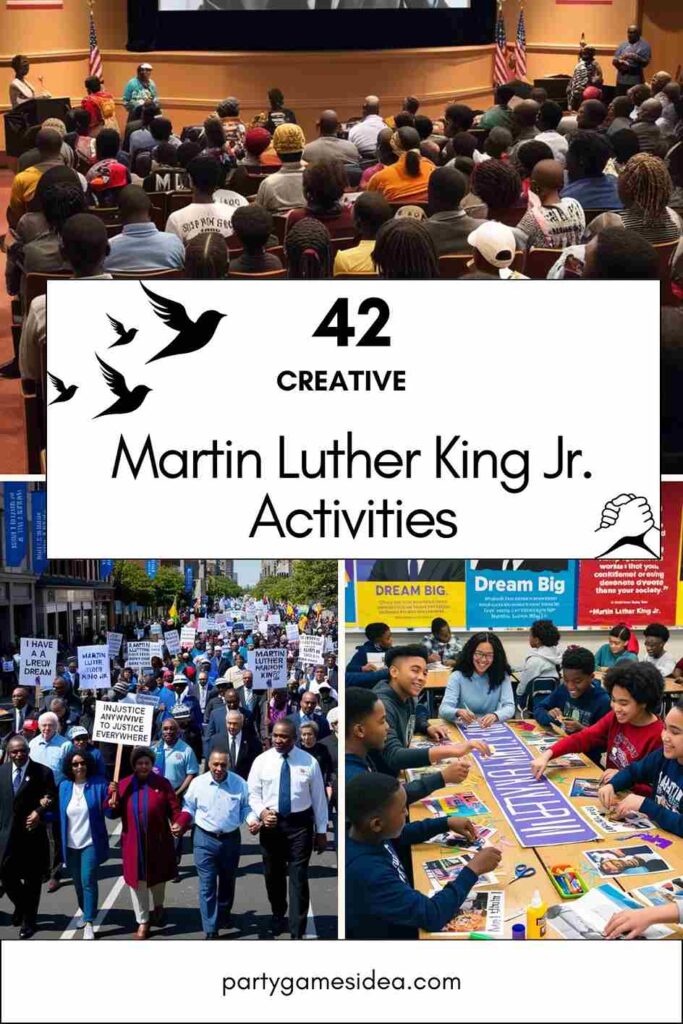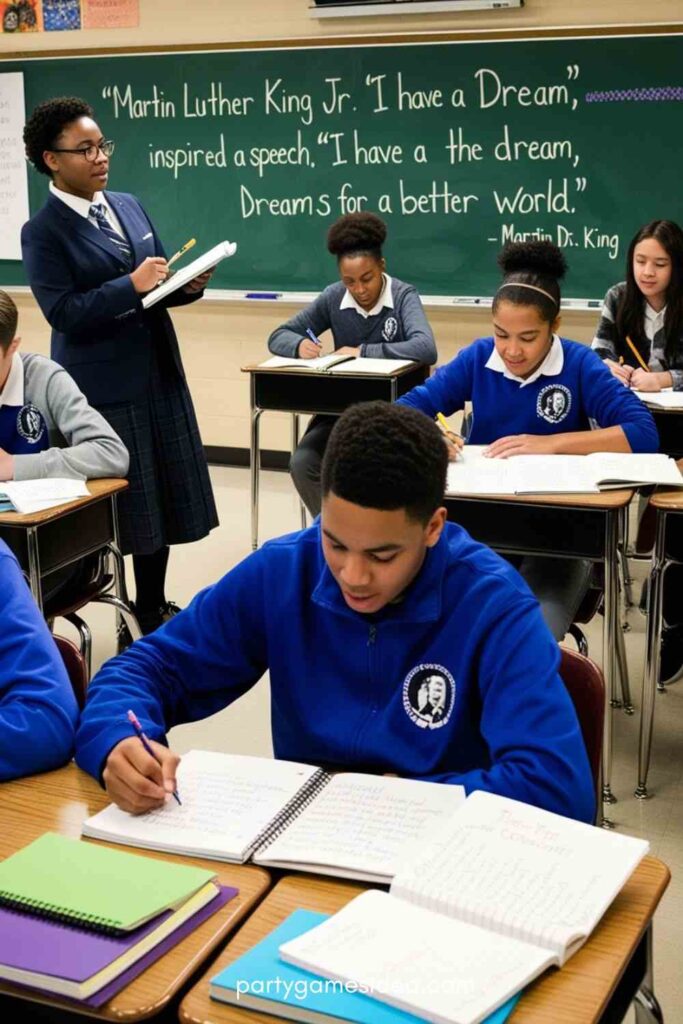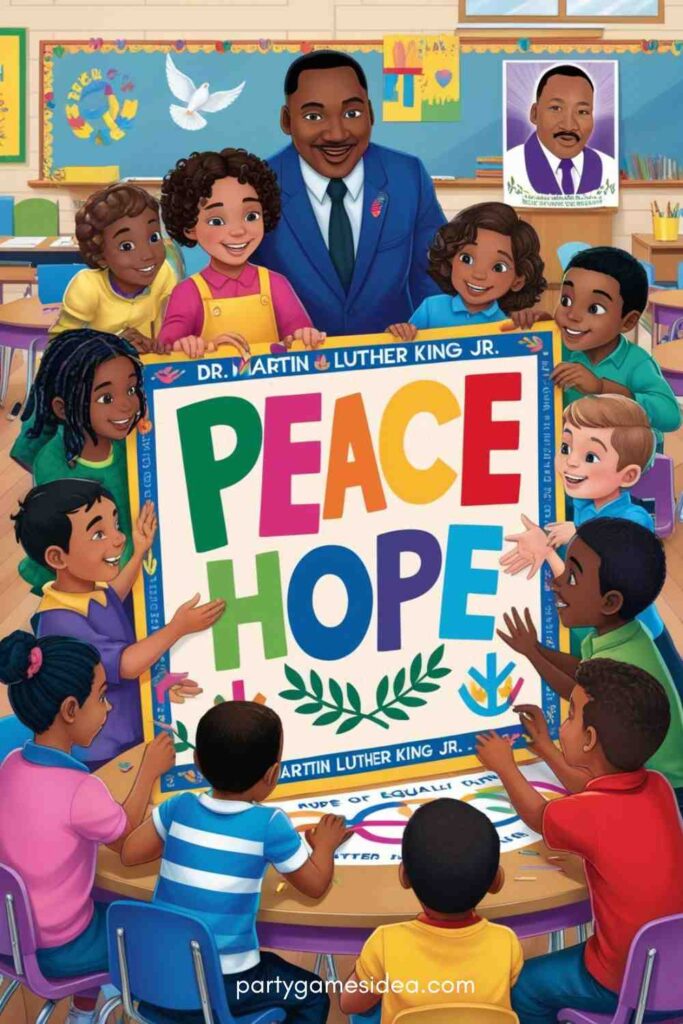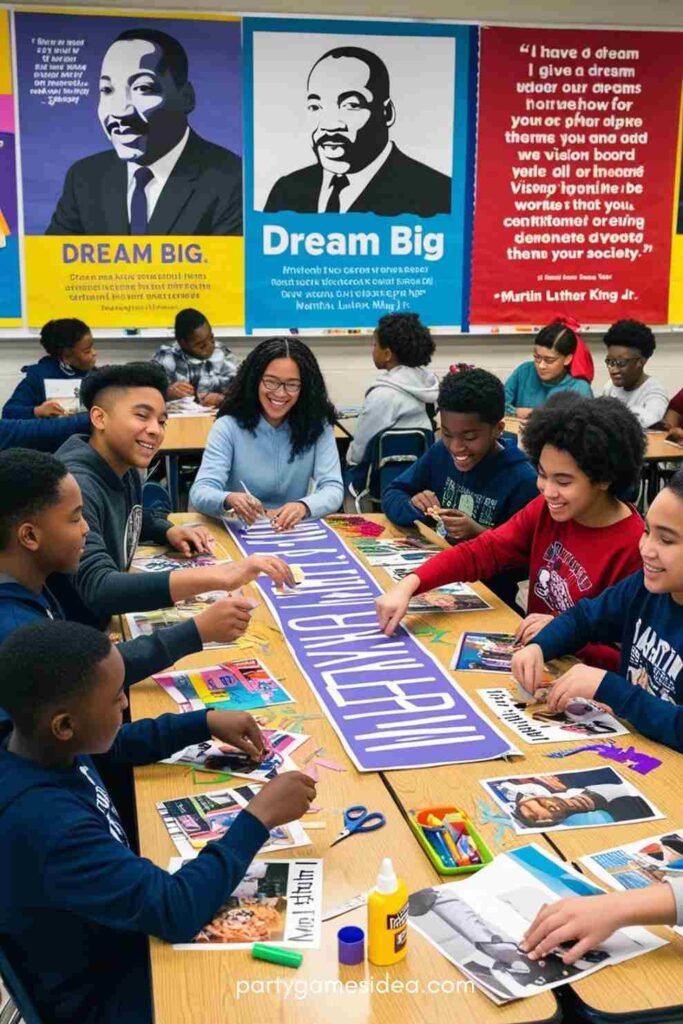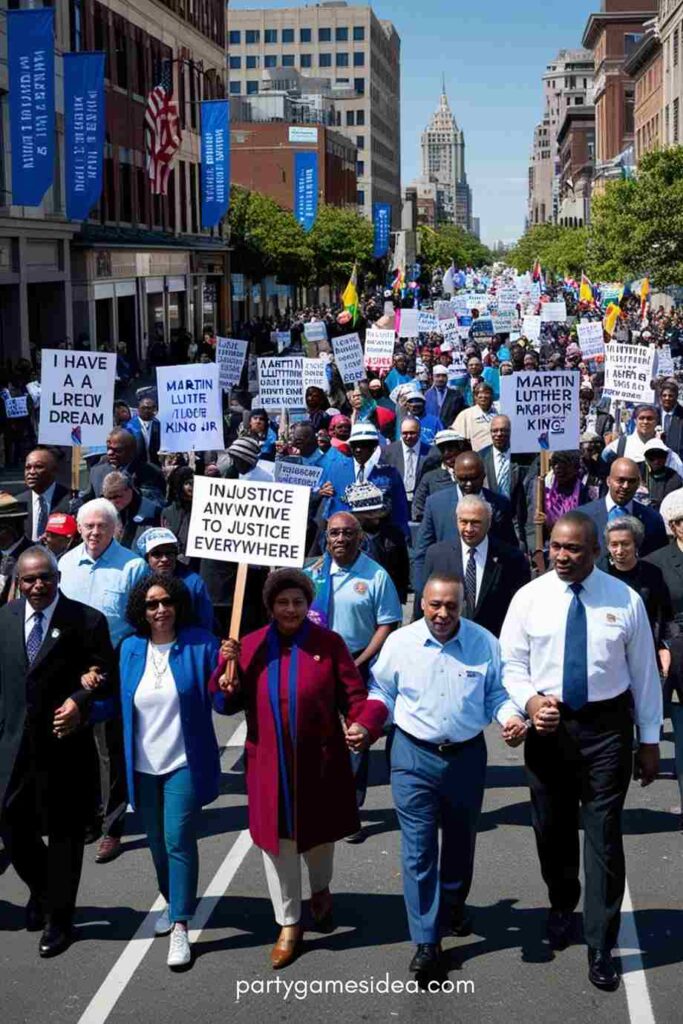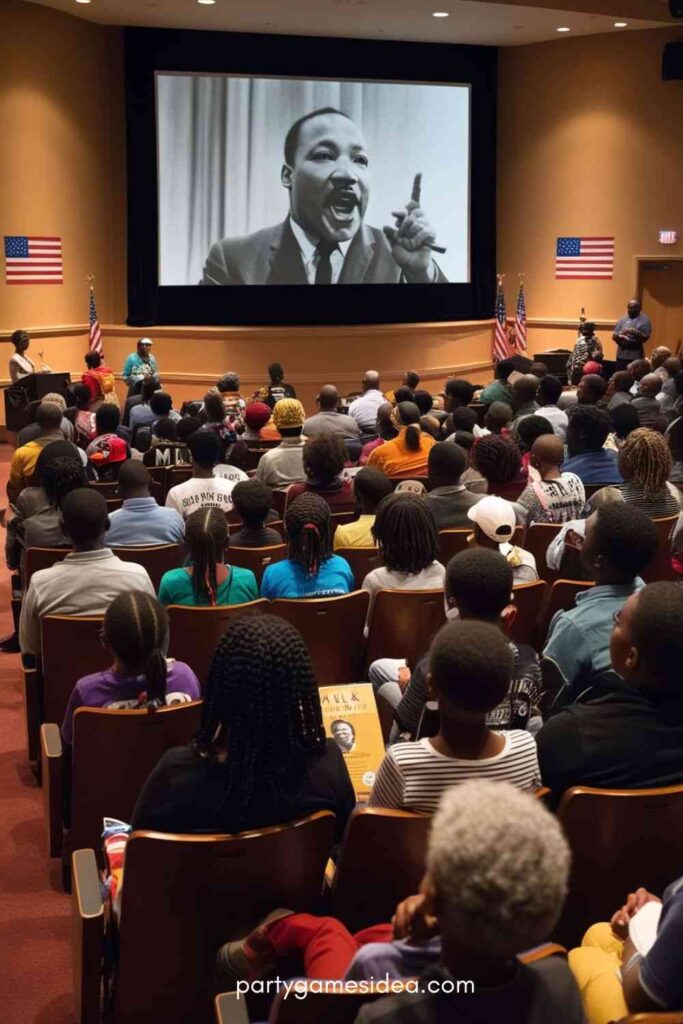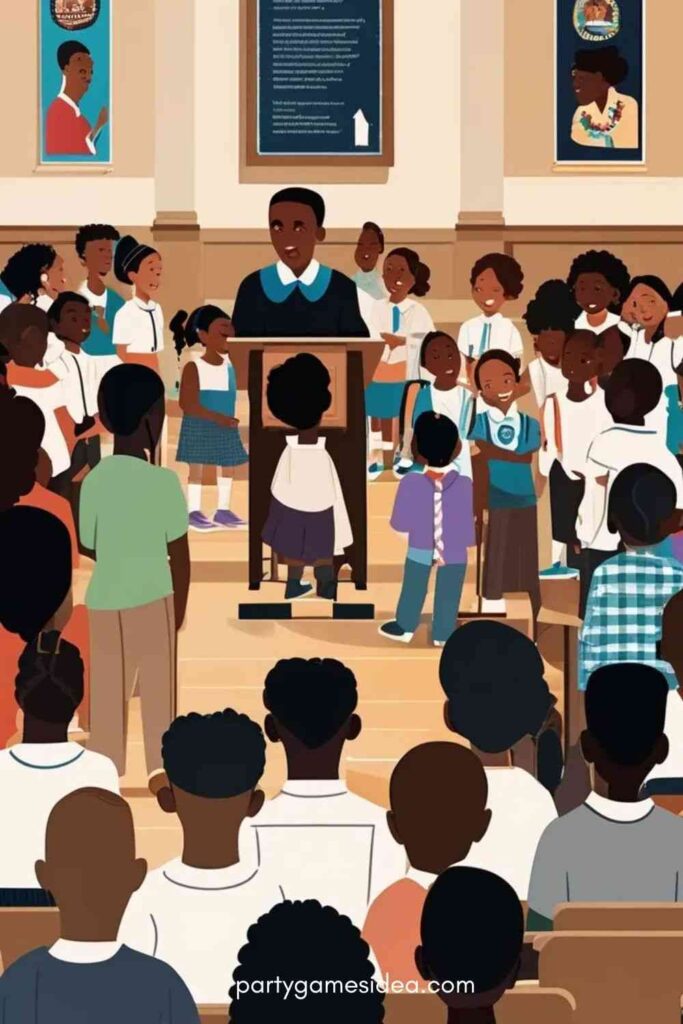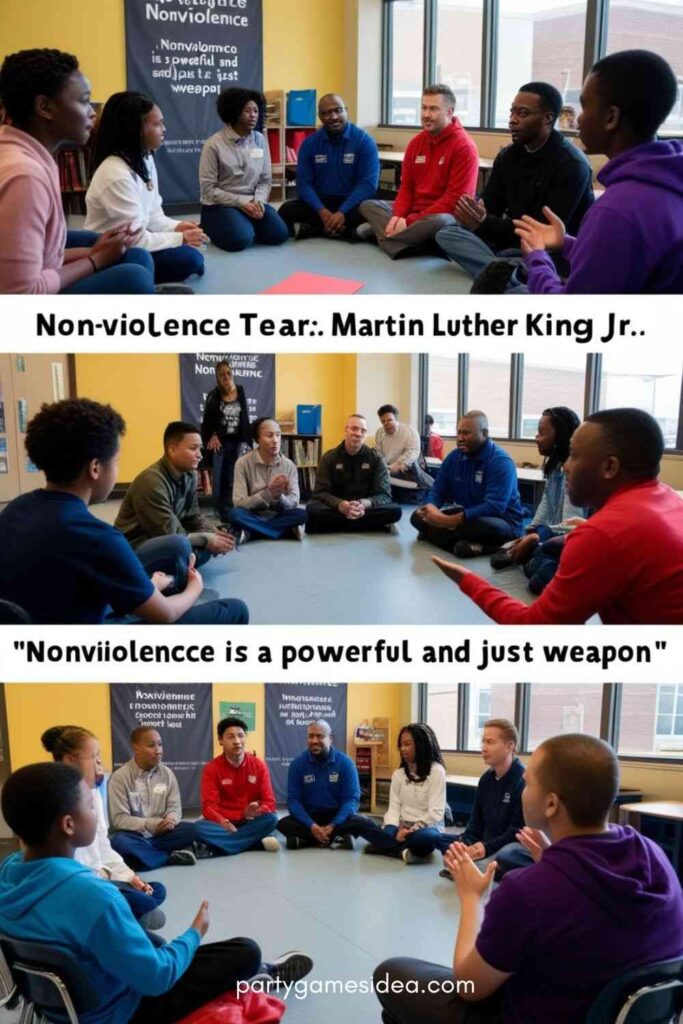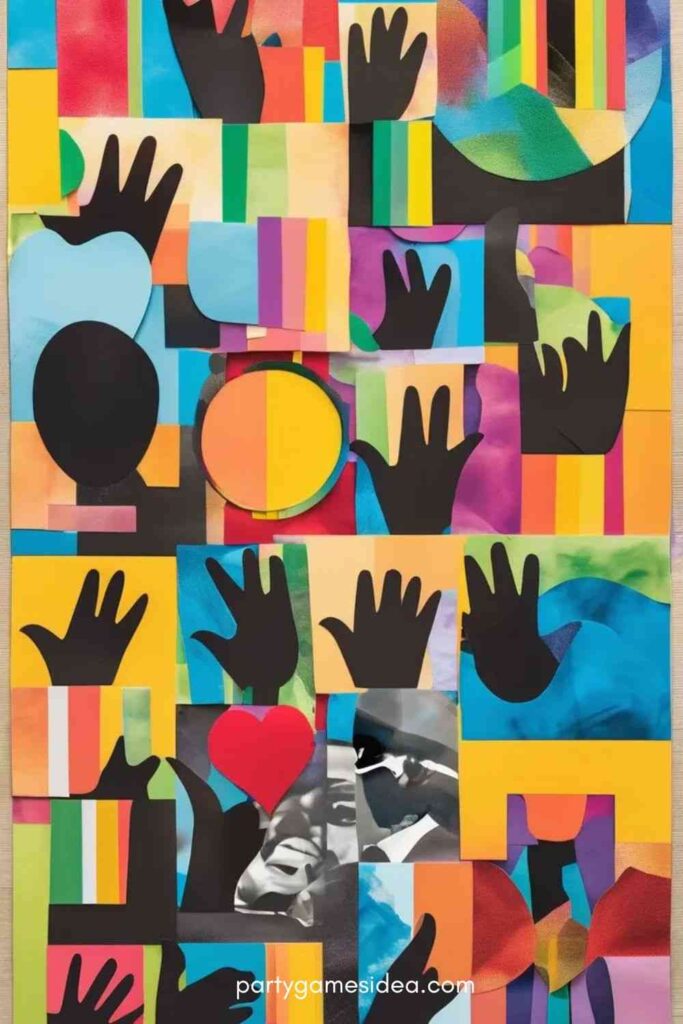Martin Luther King Jr. Activities offer a meaningful way to honor the life and legacy of a leader who profoundly impacted the United States and the world. Born on January 15, 1929, in Atlanta, Georgia, King was a Baptist minister and social activist who played a pivotal role in the Civil Rights Movement. He earned a degree in sociology from Morehouse College, followed by a divinity degree from Crozer Theological Seminary, and a Ph.D. in systematic theology from Boston University. His early activism began in the 1950s, where he quickly emerged as a leader in the fight for racial equality and justice, inspired by the nonviolent teachings of Mahatma Gandhi.
King’s most significant achievements include leading the Montgomery Bus Boycott in 1955 after Rosa Parks was arrested for refusing to give up her seat to a white man. He also organized the historic 1963 March on Washington, where he delivered his famous “I Have a Dream” speech, calling for an end to racism, segregation, and inequality. King’s advocacy for nonviolent protest, through events like the Birmingham Campaign and Selma to Montgomery marches, helped lead to landmark legislation, including the Civil Rights Act of 1964 and the Voting Rights Act of 1965. His efforts transformed American society by challenging systemic racism and inspiring generations to fight for justice and equality.
Martin Luther King Jr. Activities
Celebrating Martin Luther King Jr. through activities offers an opportunity to reflect on his legacy and to engage others in meaningful discussions about justice, equality, and nonviolent activism. Whether for classrooms, community centers, or personal reflection, these activities can help individuals of all ages connect with Dr. King’s vision.
“I Have a Dream” Speech Writing
Encourage participants to write their own “I Have a Dream” speeches. They can express their hopes for the future, focusing on equality, peace, and unity.
Tips:
- Ask them to reflect on their personal experiences or dreams for society.
- Encourage sharing speeches with the group to foster discussion on how each person’s dream contributes to the broader vision of justice.
Peace Posters
Create posters with messages of peace and equality, using bright colors, inspiring words, and symbols like doves or the American flag.
Tips:
- Provide markers, paints, and other materials to allow creativity.
- Include some of Dr. King’s famous quotes to help guide the posters.
“Dream Big” Vision Boards
Have participants create vision boards by cutting out pictures and words that represent their dreams for a better future, just as Dr. King dreamed of a world where all people are treated equally.
Tips:
- Use magazines, old books, or online printables for the images.
- Have each person present their vision board to the group, discussing the symbolism behind their choices.
Peace March
Host a peaceful march in honor of Martin Luther King Jr. and his commitment to nonviolent protest. March with signs that reflect his message of peace and unity.
Tips:
- Encourage participants to make their own signs.
- Ensure that the march is respectful and celebratory of MLK’s legacy.
MLK Documentary Screening
Watch a short documentary or film about Martin Luther King Jr.’s life, focusing on key moments such as the March on Washington and the Civil Rights Movement.
Tips:
- After the screening, host a discussion about the challenges MLK faced and the relevance of his work today.
- Provide background information for a richer experience.
“I Have a Dream” Speech Recital
Invite participants to memorize and recite parts of Dr. King’s famous “I Have a Dream” speech. This can help them understand the power of his words and how they resonate today.
Tips:
- Break the speech into sections for easier memorization.
- Encourage expression while reciting to emphasize the emotional power of the speech.
Nonviolence Role-Playing
Organize role-playing scenarios where participants act out different situations, emphasizing nonviolent ways of resolving conflict.
Tips:
- Use real-world examples or hypothetical situations where nonviolence could be applied.
- Guide discussions afterward on how nonviolence is an effective approach to difficult situations.
Unity Collage
Create a collage together that represents unity and community. Include words, symbols, and images that represent the values of equality, justice, and peace.
Tips:
- Provide newspapers, magazines, and other materials for participants to cut out and use.
- Discuss what unity means and how it can be achieved.
MLK Quote Reflection
Share powerful quotes from Martin Luther King Jr. and have participants reflect on their meaning. They can write about how the quotes inspire them or how they relate to their own lives.
Tips:
- Choose quotes that are simple and impactful.
- Encourage participants to share their reflections in a group discussion.
Handprint Pledge
Have children or participants trace their handprint on paper and write a pledge inside to stand up for equality and justice, following Dr. King’s example.
Tips:
- Provide a space for participants to share their pledges with the group.
- Frame the handprints as a lasting reminder of their commitment.
MLK Storytelling Session
Read books or excerpts from Martin Luther King Jr.’s speeches, followed by a discussion of his life and the Civil Rights Movement.
Tips:
- Choose age-appropriate books and stories.
- Allow for a Q&A after reading to ensure understanding.
“The Dream Continues” Group Art
Create a mural or large piece of art that represents Dr. King’s vision for the future, focusing on peace, love, and equality.
Tips:
- Assign different themes to sections of the mural (e.g., freedom, love, hope).
- Use different art materials like paints, markers, and fabric to make it colorful.
Drum Circle for Peace
Host a drum circle where participants play instruments to create music that symbolizes unity and harmony.
Tips:
- Provide a variety of percussion instruments like drums, tambourines, and shakers.
- Encourage rhythm and collaboration in the circle.
Civil Rights Timeline
Create a timeline of significant events during the Civil Rights Movement, highlighting Dr. King’s contributions.
Tips:
- Use visuals like photos, drawings, or printed articles to bring the timeline to life.
- Allow participants to research and add details about key moments in history.
Martin Luther King Jr. Trivia Game
Host a trivia game where participants answer questions about Martin Luther King Jr. and the Civil Rights Movement.
Tips:
- Include both easy and challenging questions to engage everyone.
- Use a buzzer system for added excitement.
MLK-Themed Crossword Puzzle
Create a crossword puzzle with key terms, events, and people related to Martin Luther King Jr. and the Civil Rights Movement.
Tips:
- Provide clues that help educate participants as they solve the puzzle.
- Offer a prize for completion to motivate participants.
Nonviolence Letter Writing
Have participants write letters to local leaders, expressing their thoughts on nonviolence and how it can be applied in their community today.
Tips:
- Provide sample letters for guidance.
- Encourage participants to make their letters personal and meaningful.
MLK Peace Song Sing-Along
Teach participants the song “We Shall Overcome” or another song associated with the Civil Rights Movement and host a sing-along.
Tips:
- Provide lyrics to make it easier for participants to sing along.
- Discuss the history and significance of the song.
Diversity Celebration
Host an event that celebrates diversity in your community, where participants can share their cultural backgrounds through food, music, and stories.
Tips:
- Encourage participants to bring something unique from their culture to share.
- Emphasize Dr. King’s belief in a society where all cultures are celebrated and respected.
“What Would MLK Do?” Scenarios
Create scenarios in which participants must decide what Dr. King might do in a particular situation, focusing on peaceful solutions and justice.
Tips:
- Make the scenarios relatable to modern-day issues.
- Facilitate group discussions after each scenario to explore different perspectives.
MLK Poetry Reading
Invite participants to write poems inspired by Dr. King’s vision and then have a poetry reading where they share their work with others.
Tips:
- Encourage the use of metaphors and imagery to capture the spirit of Dr. King’s message.
- Provide examples of MLK’s speeches to inspire the poetry.
MLK Day Scavenger Hunt
Organize a scavenger hunt where participants search for items or clues related to Martin Luther King Jr. and the Civil Rights Movement.
Tips:
- Include quotes, pictures, and historical facts in the clues.
- Provide small prizes for participants who complete the hunt.
MLK-Themed Escape Room
Design an escape room where participants solve puzzles based on Martin Luther King Jr.’s life and legacy in order to “escape.”
Tips:
- Create puzzles that incorporate MLK’s quotes, milestones, and principles of nonviolence.
- Ensure that the puzzles are challenging yet fun for all age groups.
MLK Video Message
Ask participants to create short video messages or skits that explain what Martin Luther King Jr.’s life and work mean to them today.
Tips:
- Encourage creativity by using props or costumes related to Dr. King’s time.
- Showcase the videos at the end of the activity to foster a sense of pride.
Equality Chain of Hands
Participants join hands in a circle to create a symbolic “chain of equality” and share one thing they will do to promote equality in their own communities.
Tips:
- Encourage each participant to say something that connects them to Dr. King’s vision of equality.
- Use the chain of hands to symbolize unity and strength in numbers.
MLK Reflection Journals
Provide participants with journals to write reflections on Dr. King’s teachings and how they can apply them to their own lives.
Tips:
- Include writing prompts like “How can I practice nonviolence today?” or “What is my dream for the future?”
- Allow time for participants to share excerpts from their journals if they wish.
Create an MLK Wall of Dreams
As a group, create a wall where everyone can pin their dreams for a better world. This activity mirrors Dr. King’s “I Have a Dream” speech, creating a collective vision for change.
Tips:
- Use sticky notes or cards for easy additions to the wall.
- Encourage participants to read other dreams and reflect on shared goals for the future.
These activities provide a wide range of opportunities for reflecting on Martin Luther King Jr.’s legacy while engaging people of all ages in meaningful, interactive experiences.
Community Service Projects
Community service projects provide a powerful way to give back to the community while honoring Martin Luther King Jr.’s legacy of service and social justice. Dr. King believed that individuals should work together to improve society and uplift those in need. Community service projects embody this belief by promoting kindness, generosity, and collective responsibility. These projects are an excellent way to engage people of all ages and backgrounds, helping them connect with Dr. King’s vision of a just and compassionate society.
Volunteer Activity
Organizing a community service day offers participants the opportunity to help others in tangible ways. Activities can include cleaning up local parks, assisting elderly neighbors, or volunteering at food banks or shelters.
Tips:
- Plan projects that address specific community needs, like park clean-ups, neighborhood beautification, or helping a local school.
- Encourage participants to volunteer in groups to promote teamwork and community bonding.
- Discuss how Martin Luther King Jr.’s commitment to serving others and fighting injustice through action inspired individuals to actively contribute to their communities.
- After the service project, hold a reflection session where participants can discuss their experiences and how their actions align with Dr. King’s ideals.
Donation Drive
A donation drive is another meaningful way to give back to the community by collecting items such as clothes, non-perishable food, books, or toiletries. Participants can donate these goods to local shelters, food banks, or other charitable organizations in need.
Tips:
- Set up collection stations at schools, churches, or community centers to make it easy for people to contribute.
- Organize a competition or challenge to see which group can donate the most items or raise the most funds.
- Share stories of how Dr. King promoted the importance of giving, compassion, and supporting those less fortunate.
- Host a “thank you” event for all participants where the collected donations are delivered to the charity, reinforcing the impact of their efforts.
Both volunteer activities and donation drives allow people to engage directly with Martin Luther King Jr.’s legacy by taking concrete steps toward positive change in their communities. By reflecting on his messages of service, equality, and social justice, participants are empowered to make a lasting impact.
Multimedia and Technology Activities
Incorporating multimedia and technology into Martin Luther King Jr. activities offers a dynamic way to engage participants while deepening their understanding of his life and legacy. These activities leverage the power of visuals, videos, and digital tools to help convey the significance of MLK’s work, making his messages more accessible and impactful for all ages.
MLK Documentary Screening
Watching a short documentary or educational video about Martin Luther King Jr.’s life and achievements provides a powerful and engaging way to learn about his impact on society. The visual medium brings his story to life, showcasing key moments such as the March on Washington, his speeches, and his advocacy for civil rights.
Tips:
- Choose a documentary appropriate for the age group to keep them engaged and informed.
- Pause the video at key moments to discuss Dr. King’s actions and their significance.
- Encourage participants to share their thoughts and feelings after watching, fostering a deeper reflection on MLK’s life and message.
Digital Art
Digital art activities provide a creative outlet for participants to explore Martin Luther King Jr.’s legacy through technology. Creating digital posters, images, or slideshows allows individuals to express their understanding of Dr. King’s values, such as equality, peace, and justice, in a modern and visually striking way.
Tips:
- Use free online tools like Canva or Adobe Spark to help participants create digital art.
- Focus on themes like unity, nonviolence, and equality when designing the artwork.
- Display the finished pieces in a digital gallery or share them on social media to spread awareness of MLK’s contributions.
These multimedia and technology activities not only teach about Martin Luther King Jr.’s life and work but also allow participants to creatively engage with his messages, ensuring his legacy is preserved in innovative and accessible ways.
FAQ
What are some meaningful Martin Luther King Jr. activities for schools?
For schools, activities like creating peace posters, writing “I Have a Dream” speeches, and organizing community service projects are powerful ways to honor Martin Luther King Jr.’s legacy. These activities encourage students to reflect on themes of equality, justice, and service while engaging them in creative and educational tasks. Additionally, having discussions about Dr. King’s life, screening documentaries, and conducting nonviolence role-playing exercises can help deepen understanding and inspire action.
Points to Consider:
- Encourage student participation in creating art or writing that reflects MLK’s values.
- Host discussions about how his work impacts modern society.
- Incorporate Dr. King’s speeches to help students practice public speaking and reflection.
How can I incorporate MLK’s message of nonviolence into activities?
Incorporating MLK’s message of nonviolence can be done through role-playing activities where participants are asked to resolve conflicts peacefully. Discussing modern examples of nonviolent protests or peaceful conflict resolution methods also helps reinforce his message. Additionally, organizing nonviolence-themed games, such as “What Would MLK Do?” scenarios, allows participants to think critically about the power of peaceful solutions.
Points to Consider:
- Use real-life examples of nonviolent actions, like the Civil Rights Movement or current peaceful protests.
- Encourage group discussions about why nonviolence is a powerful form of protest.
- Introduce role-playing games that emphasize resolving conflict without aggression.
How do community service projects relate to Martin Luther King Jr.’s work?
Martin Luther King Jr. believed that service to others was essential in creating a better society. Community service projects directly align with his message of giving back and addressing societal needs. Projects like food drives, park clean-ups, and helping the elderly allow individuals to make a tangible impact in their communities while honoring MLK’s commitment to justice, equality, and service.
Points to Consider:
- Choose service projects that address current local needs.
- Reflect on how Dr. King’s work was centered on uplifting others.
- Use community service as a tool to build unity and strength within the community.
What can we learn from Dr. King’s speeches during these activities?
Dr. King’s speeches, especially his “I Have a Dream” speech, are powerful sources of inspiration. During activities, discussing key parts of his speeches can help participants understand his ideals of equality, justice, and nonviolence. Encouraging participants to reflect on these words in the context of today’s world provides a deeper understanding of his message and its relevance. Activities like speech recitals or group discussions about his words are excellent ways to honor his legacy.
Points to Consider:
- Select key quotes or excerpts from Dr. King’s speeches to discuss.
- Encourage participants to memorize or recite his speeches to experience the impact of his words.
- Use Dr. King’s speeches as a starting point for conversations about societal progress and challenges.
How can we make Martin Luther King Jr. Day engaging for all ages?
To make MLK Day engaging for all ages, it’s important to tailor activities to the audience. For children, craft projects, story time, and role-playing activities work well. For teens and adults, you can focus on discussions, community service projects, or group reflections. Hosting events such as a march, a film screening, or a poetry reading offers something for everyone while allowing participants to connect with Dr. King’s message in meaningful ways.
Points to Consider:
- Adjust the complexity of activities based on age and understanding.
- Incorporate a mix of creative, reflective, and action-based activities.
- Use group activities to encourage collective reflection and collaboration.

Hi, I’m Hailey Say, the proud mom and owner of PartyGamesIdea.com. As a dedicated party designer and an expert in party ideas, I have a deep passion for crafting memorable and enjoyable experiences for every occasion. From holiday games to baby showers, bridal showers, bachelor parties, group gatherings, and more, I specialize in creating unique and fun party ideas that cater to all age groups and interests.
With an extensive collection of ideas ranging from printable games, teen and adult games, kids’ party activities, birthday party games, girls’ games, memory games, family games, and outdoor games, I aim to make every event special. My expertise also extends to themed parties such as dinner parties, brunch parties, graduation celebrations, college parties, and fun night games.
On PartyGamesIdea.com, I share my passion and creativity, helping people turn their party visions into reality. With years of experience and a keen eye for detail, I am committed to making your event planning process enjoyable and stress-free. Join me on PartyGamesIdea.com, and together, we’ll create unforgettable memories for you and your loved ones.

